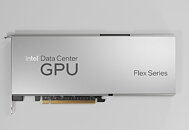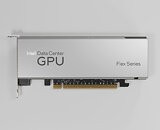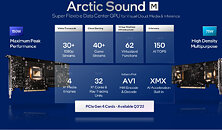- Joined
- Oct 9, 2007
- Messages
- 47,244 (7.55/day)
- Location
- Hyderabad, India
| System Name | RBMK-1000 |
|---|---|
| Processor | AMD Ryzen 7 5700G |
| Motherboard | ASUS ROG Strix B450-E Gaming |
| Cooling | DeepCool Gammax L240 V2 |
| Memory | 2x 8GB G.Skill Sniper X |
| Video Card(s) | Palit GeForce RTX 2080 SUPER GameRock |
| Storage | Western Digital Black NVMe 512GB |
| Display(s) | BenQ 1440p 60 Hz 27-inch |
| Case | Corsair Carbide 100R |
| Audio Device(s) | ASUS SupremeFX S1220A |
| Power Supply | Cooler Master MWE Gold 650W |
| Mouse | ASUS ROG Strix Impact |
| Keyboard | Gamdias Hermes E2 |
| Software | Windows 11 Pro |
Intel today launched its Arctic Sound M line of data-center GPUs. These are not positioned as HPC processors like the "Ponte Vecchio," but GPUs targeting cloud-compute providers, with their main applications being in the realm of visual processing, media, and AI inferencing. Their most interesting aspect has to be the silicon, which are the same 6 nm "ACM-G11" and "ACM-G10" chips powering the Arc "Alchemist" client graphics cards, based on the Xe-HPG architecture. Even more interesting is their typical board power values, ranging between 75 W to 150 W. The cards are built in the PCI-Express add-on card form-factor, with their cooling solutions optimized for rack airflow.
The marketing name for these cards is simply Intel Data Center GPU Flex, with two models being offered: The Data Center GPU Flex-140, and Flex-170. The Flex-170 is a full-sized add-on card based on the larger ACM-G10 silicon, which has 32 Xe Cores (4,096 unified shaders), whereas the Flex-140, interestingly, is a low-profile dual-GPU card with two smaller ACM-G11 chips that each has 8 Xe Cores (1,024 unified shaders). The two chips appear to be sharing a PCIe bridge chip in the renders. Both models come with four Xe Media Engines that pack AV1 encode hardware-acceleration, XMX AI acceleration, real-time ray tracing, and GDDR6 memory.




The graphics processing capabilities lend Arctic Sound-M the ability to be deployed as a cloud-gaming GPU, although Intel is only positioning it for Android games. The overarching software stack is led by oneAPI, for parallel compute, AI deep-learning, inferencing, as well as media transcode and streaming acceleration. It also features full-stack VDI (virtual desktop) support, so large organizations can provide its capabilities to their employees working from anywhere. Media processing and Android cloud-gaming will lead the target applications for these GPUs initially, with the other applications being added to the feature-set soon.
Among the operating systems supported are Windows 10 (client versions only), Windows Server 2019, Windows Server 2022, and various kinds of Linux that include RHEL, CentOS, Debian, and Ubuntu). The company hasn't disclosed pricing (we asked), but mentioned a Q3-2022 availability.
View at TechPowerUp Main Site
The marketing name for these cards is simply Intel Data Center GPU Flex, with two models being offered: The Data Center GPU Flex-140, and Flex-170. The Flex-170 is a full-sized add-on card based on the larger ACM-G10 silicon, which has 32 Xe Cores (4,096 unified shaders), whereas the Flex-140, interestingly, is a low-profile dual-GPU card with two smaller ACM-G11 chips that each has 8 Xe Cores (1,024 unified shaders). The two chips appear to be sharing a PCIe bridge chip in the renders. Both models come with four Xe Media Engines that pack AV1 encode hardware-acceleration, XMX AI acceleration, real-time ray tracing, and GDDR6 memory.




The graphics processing capabilities lend Arctic Sound-M the ability to be deployed as a cloud-gaming GPU, although Intel is only positioning it for Android games. The overarching software stack is led by oneAPI, for parallel compute, AI deep-learning, inferencing, as well as media transcode and streaming acceleration. It also features full-stack VDI (virtual desktop) support, so large organizations can provide its capabilities to their employees working from anywhere. Media processing and Android cloud-gaming will lead the target applications for these GPUs initially, with the other applications being added to the feature-set soon.
Among the operating systems supported are Windows 10 (client versions only), Windows Server 2019, Windows Server 2022, and various kinds of Linux that include RHEL, CentOS, Debian, and Ubuntu). The company hasn't disclosed pricing (we asked), but mentioned a Q3-2022 availability.
View at TechPowerUp Main Site



